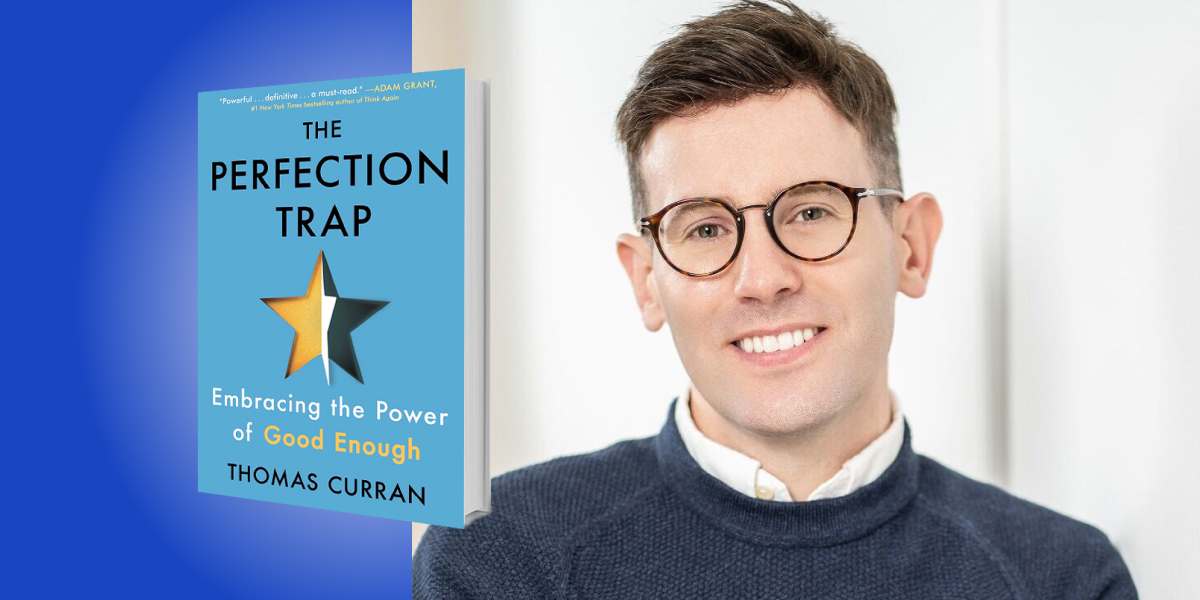Thomas Curran is an Assistant Professor in the Department of Psychological and Behavioural Science at the London School of Economics. He has written for the Harvard Business Review, was featured in the New Scientist, and his work has been covered by publications including the Guardian, Telegraph, Wall Street Journal, and Ariana Huffington’s ‘Thrive Global’ campaign.
Below, Thomas shares five key insights from his new book, The Perfection Trap: The Power of Good Enough in a World That Always Wants More. Listen to the audio version—read by Thomas himself—in the Next Big Idea App.

1. Perfectionism is not the same as high standards.
Many people believe perfectionism is about high standards, standards that define perfectionists. But we need to look closer. Because when we do so, we find that high standards are what we see on the surface. The deeper question is why perfectionistic people need to set those standards in the first place. Research shows they’re doing so for validation from other people—validation that tells them they’re good enough, that they matter, or are loved. Until we recognize that simple fact, we’ll continue to misunderstand what perfectionism is and what exactly it does to us.
My late grandfather was, in many ways, a perfect example of the distinction between high standards and perfectionism. As a child, I used to sit for hours in wide-eyed bewilderment as Pappy, a master carpenter, fashioned everyday things like banisters, chairs, and window frames from the very first plank to the final ferrule.
I marveled at his craft. Every Sunday, I’d scuttle through the estate to his bungalow and watch intently as he showed me how to cut pieces of reclaimed timber into perfectly measured strips of wood. Then he’d delicately carve and contour each strip, carefully mark and saw the strips with military precision, before slotting them crisply together. Then he’d fix them tightly with screws and tenderly sand and polish the finished article. The contours of his wares were always perfectly formed, the wood deliciously smooth, the end result a piece of immaculate, functional art.
These are unquestionably the traits of a person with extremely high standards. But they’re not the traits of a perfectionist. When my grandfather was done in his workshop, he’d gather up the wares he’d lovingly crafted and deliver them to their new homes, then simply leave them there, without loitering for validation or a five-star review. He brought everyday things into the world for other people to use and appreciate. As far as he was concerned, his wares needed to exist way more than their maker needed to be loved.
“Perfectionism is—can only ever be—a relational trait.”
That’s the thing about high standards: they don’t have to come with insecurity. Only perfectionism grafts the two together. Perfectionism isn’t about perfecting things or tasks, nor is it about striving for especially high standards in, say, your assignments, appearances, parenting, or relationships. It’s far, far deeper than that. It’s about perfecting ourselves, or to be more exact, perfecting our imperfect selves; going through life on the defensive, concealing every last blemish, flaw, and shortcoming from those around us.
Perfectionism is—can only ever be—a relational trait. It is a self-esteem issue, arising not in a vacuum within individuals, but in our social world and through the interactions we have with those around us. It starts with an inner dialogue that says, “I’m not attractive enough, cool enough, rich enough, skinny enough, healthy enough, intelligent enough, productive enough.” This train of thought finishes with a brute realization: “Whenever my shortcomings are revealed, other people will notice, and I’ll be a less acceptable person in their eyes.” Every ounce of energy from that realization onward is used to hide our real selves from the world and do everything we possibly can to strengthen what we think are threadbare, perfection-contingent ties binding us to other people.
That’s not high standards. That’s shame embodied in a deeply problematic relationship with ourselves and other people.
2. Perfectionism has many faces.
Over the last four decades, psychologists Paul Hewitt and Gordon Flett have been working with struggling perfectionists, trying to figure out what perfectionism looks like and pinpoint the thoughts, feelings, and behavior that perfectionistic people typically report. In case after case, these men were observing people who felt compelled to be perfect not just to ape their own impossible standards—though they did this in great measure—but also to ape the impossible standards they felt were being imposed on them by others, and that they themselves imposed on those around them.
These different faces—self-directed, socially imposed, and other-directed—became the basis of their groundbreaking, multidimensional model. Self-oriented, perfectionism is an intense need to be perfect and nothing but perfect. Socially-imposed, or socially-prescribed perfectionism is a sense that everyone around me expects me to be perfect. Other-directed, or other-oriented, perfectionism is turned outwards onto other people.
The intricate interplay of self-oriented, socially-prescribed, and other-oriented perfectionism is why Hewitt and Flett don’t treat perfectionism as a classification, but rather as a spectrum. Some are higher on self-oriented perfectionism, while others are lower on socially prescribed and other-oriented. Of course, knowing how where we are on the spectrums of perfectionism requires a tool to measure them. Which is why, back when Hewitt and Flett embarked on their journey, the very first thing they did was develop a perfectionism scale to capture the full array of perfectionistic thoughts, feelings, and behaviors. Some of these trends will apply a great deal to you, others not so much. That’s the most interesting thing about perfectionism: there’s no one-size-fits-all.
3. Perfectionism is not the secret to success.
It’s hard to succeed nowadays; you’ve got to sacrifice yourself, keep grinding through the pain, and even then, most won’t make it to the very top—that’s just the nature of zero-sum battle in the modern economy. To get ahead in this world, aren’t we going to need a little bit of perfectionism?
In diverse domains such as school, sports, and work, self-oriented perfectionism reveals itself to be a highly potent motivating force, correlating with a powerful work ethic and contributing to dogged persistence in even the most mundane of tasks. There’s even compelling evidence that it can contribute to pathological forms of striving—most notably workaholism. Yet, despite this breathless striving, studies find that perfectionism has negligible to non-existent correlations with performance. This is perplexing. What explains this paradox?
“Perfectionism has negligible to non-existent correlations with performance.”
There are two reasons. The first is that perfectionistic people work hard, but it’s unsustainably hard—pushing themselves to the limit and then some. They often find themselves in the sapping zone of diminishing and inverse returns to their efforts. Left unchecked, that ends in burnout.
The second reason that perfectionistic people cannot turn all their striving into high performance is that perfectionists are world champion self-sabotagers. When things get tough, when failure looks like it’s heading their way, the anticipated shame and embarrassment are so fierce that it makes perfectionistic people reluctant to put forward any further effort—an effort that would make other people’s discovery of their shortcomings a little easier. So what do they do? They self-sabotage—procrastinate or simply give up—to save face and ward off immobilizing fears of failure.
Perfectionism’s success paradox, then, is actually a paradoxical relationship with failure. In its avoidance, perfectionists do the very things that seem to make it more likely. That’s why perfectionism is not the golden ticket to success that we mistake it for.
4. Perfectionism is a hidden epidemic.
Anyone who spends time with young people would surely agree they’re under intense pressure. This is pressure that the National Education Association calls an “epidemic,” the Association of Child Psychotherapists calls a “silent catastrophe,” and the Royal College of Psychiatrists calls a “crisis.” A 2017 survey asked about 25,000 elementary and high school students in Toronto whether they felt the need to be perfect. More than one in two said that they did, which is bad enough. But 34 percent of elementary school students and 48 percent of high schoolers went further and said they felt under specific pressures to appear physically perfect in every possible way.
Which is why, the same year, I set myself a challenge. I wanted to know if perfectionism was increasing over time.
It was a tricky task. I was only able to do it by using Hewitt and Flett’s Multidimensional Perfectionism Scale in a slightly different way. Since its development in the late 80s, this tool has been used in thousands of research projects, most of which sample college students in the US, Canada, and the UK. Instead of using that treasure trove of data to study relationships like it was designed to do, I used it like a historical tracker to compare young people across generations and figure out whether more recent ones are reporting higher or lower levels of perfectionism.
What I found was startling. Self-oriented and other-oriented perfectionism have ticked upwards. They’re not on a huge rise, but increases are significant, nonetheless. However, the trend for socially-prescribed perfectionism is concerning. Right now, it’s following an exponential trajectory upwards, one that bends as the rate of increase accelerates over time. From the bottom of the trajectory to the top, socially prescribed perfectionism is about seven percent higher today in crude terms. In comparative terms, that difference is even more dramatic. Today’s typical young person would’ve scored at the seventieth percentile of socially prescribed perfectionism scores in 1988—a staggering 40 percent increase.
“Society’s expectations are well beyond the capacity of most people to meet.”
Certainly, a great frequency of socially prescribed perfectionism tells us that something is seriously wrong with the conditions under which we live. It tells us, in essence, that society’s expectations are well beyond the capacity of most people to meet. Since those expectations are all-consuming, the problems they end up creating get buried under a weight of conventional wisdom that has essentially normalized our favorite flaw.
Right there in open daylight, disguised in plain sight by its very ubiquity, perfectionism is today’s hidden epidemic—the conspicuous vulnerability that’s wreaking all sorts of havoc among those who’re coming-of-age in modern society.
5. Perfectionism is a cultural phenomenon.
In our individualistic culture, it’s hard to envisage perfectionism as anything other than a personal trait. However, my work rose to prominence on the back of a curious finding: perfectionism is rising for everyone. Socially prescribed perfectionism—the belief that our environment demands perfection—is rising most rapidly. Those two facts point not to something going wrong within us, but rather to something going wrong within our society.
From pushy parents, to high and excessive expectations in schools and colleges, to intense workplace pressures, to the comparative lens of social media, and everywhere in between, perfection is inescapable these days.
There is a need to do more, be more. The need to hustle and grind and overachieve has infiltrated almost every corner of modern society. In this kind of culture, it’s not sufficient to say that with a bit of positive thinking, we can overcome immobilizing perceptions of not being enough. These are more than just perceptions; they’re logical and rational feelings equal in intensity to the relentless conditioning that’s generating them.
This isn’t your fault. You are enough. The culture you live inside, the one that consumes and surrounds you, just doesn’t give you the permission to breathe in your incomprehensible existence and truly accept it.
If you can get your head around that, if you can value and love yourself for the breathtaking human being that you are, then you’ll be able to take the very worst that this world can throw at you. Everything you feel that you should be is a set of ideas conditioned by our culture, ideas that are there purely to grow your economy. Our ability to fully transform ourselves within those structural constraints is limited, at least for now. But the future can give us hope. The hope for future change is honest. It is hope that confronts the world as it actually is. It is hope that’s not going to mislead you with false promises of individual transformation. It is hope that the first thing we need to realize is that it’s not us that needs transforming.
To listen to the audio version read by author Thomas Curran, download the Next Big Idea App today:































